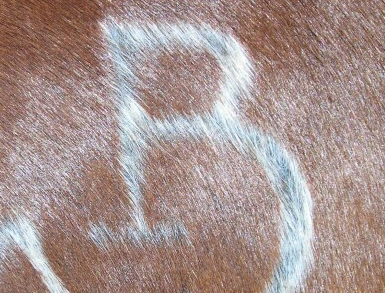Cattle are often branded to assist with identification and prevent theft by giving the livestock a distinctive marking. Farmers use a heated iron to leave a lasting scar on the animal, preventing it from being removed or altered. Every farm and ranch has its own distinctive brand identifier, as well as its own particular spot on the cow for branding livestock.
For many years, branding has been a sign of the ranching lifestyle. Branding has long been seen as the essence of livestock ranching in the Western art motif. A common branding image includes an ancient wooden corral, ropers on horses, ranchers kneeling next to a calf, and a large, open sky in the backdrop.
The day of branding is particularly significant for the health of the calves. The calf is marked on the hip, which preserves the quality of the hide and complies with Beef Quality Assurance industry guidelines. The process takes just a fraction of a second, and handlers are competent to minimize the calf's pain. After getting a brand and vaccinations, a calf is returned to its mother and pasture within hours.
Branding Cattle Pros
Cattle are branded in order to give them a distinctive identity that will aid in identification and prevent theft. In the western part of the US, where cattle from several ranches are run together or in nearby grazing land, it is the primary method of establishing permanent identification and evidence of ownership for livestock. Calves that have been marked can be immunized against diseases, theft from cattle rustlers can be avoided, information on the health and population of the herd can be obtained, and ranchers and ranch workers can check the calf out, give it immunizations, and make sure it's healthy. In the industry of purebred cattle, a brand is commonly used to identify the original owner of an animal after a change in ownership.

The USDA favors using RFID tags for identification. They are semi-permanent and enable effective tracking, so numerous farms are incorporating them into their program. They make it much simpler to keep track of the herd's records, which is another important benefit they bring to the operation. Other types of permanent or semi-permanent identification include metal clip tags, breed tattoos, radio frequency identification (RFID) boluses, and microchips (implanted in inedible tissue).
Branding Cattle Cons
This painful process has a number of disadvantages, including heavy injury to the hide and concerns for the animal's wellbeing. A few studies have examined the suffering brought on by the different types of branding. The conclusions are listed here:
Both freeze and hot-iron branding are more excruciating than sham branding, and both are more painful than the latter. (restraint and pressure with a cold branding iron)
The most excruciating part of hot-iron branding occurs when the brand is being applied, whereas the most excruciating part of freeze branding occurs 15 to 30 minutes after the task is completed.
Branding with a hot iron is associated with higher levels of inflammation than freeze branding. Cattle avoidance behaviour suggests that hot-iron marks may remain painful for a minimum of 8 weeks. This research also demonstrated that a reduction in this effect could not be achieved by administering a dosage of the anti-inflammatory medication flunixin.
Another study found that the anti-inflammatory drug meloxicam, when injected, may aid to lessen the pain associated with hot-iron branding.









0 Comments